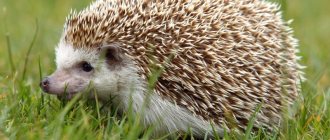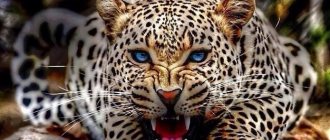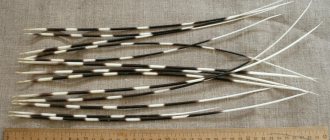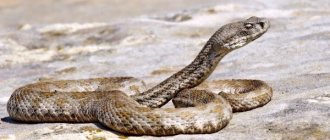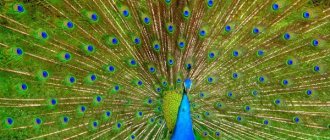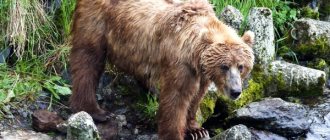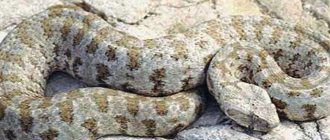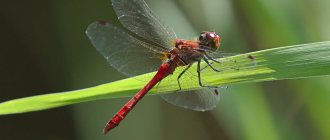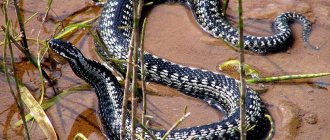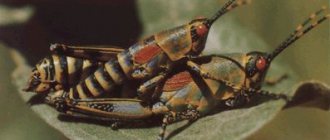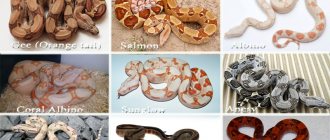Cottonmouth is a widespread genus of snakes of the subfamily Pitviperidae of the viper family. A characteristic feature is large scutes on the top of the head. A snake with a beautiful color is poisonous and sometimes quite dangerous.
Despite their poisonous nature, copperheads are kept in captivity. The photo shows Taylor's copperhead.
Origin story
Pit snakes or rattlesnakes are a subfamily of venomous snakes in the viper family . It has more than 160 species. Of these, 13 are copperheads.
All these types of snakes are poisonous. The venom of pit snakes contains enzymes that destroy tissue and clot blood.
The Mexican copperhead is one of the most beautiful and brightest in body color among the representatives of the genus.
Pit heads are so called because of the special dimples between the eyes and nasal openings. This heat-sensitive pit organ is the main feature of the subfamily.
At first, all species of copperhead were classified in the genus Agkistrodon. Later there was a division. Agkistrodon now includes only the American species of cottonmouth . Asians are classified in the genus Gloydius (genus of Asian pit snakes) .
How dangerous are sea snakes?
Some of the most poisonous snakes are sea snakes. But they are almost not dangerous for us, this is due to the structure of their mouths and peaceful disposition: they do not attack a person without a good reason.
In order for a sea snake to bite you, you need to stick your finger halfway straight into its mouth!
But their poison is extremely toxic, since the main food is fish, which is quickly carried away by the current. This means that the snake needs to kill it faster than warm-blooded animals. Many tropical fish are much more dangerous than sea snakes: stingrays, scorpionfish, zebra fish. Octopuses off the coast of Australia and cone clams are poisonous. But you shouldn’t be afraid of sea snakes, but you shouldn’t grab them either, ” explained Igor Doronin.
One of the varieties of sea snakes.
Description and photo of the copperhead
The snake genus includes small and medium-sized species, most of which are less than a meter in length. The body of the snake, including its tail, grows from 60 to 90 cm.
Variety of colors using the example of the aquatic cottonmouth.
Primary colors:
- light gray
- light brown,
- reddish brown
- orange.
Common cottonmouth in its natural environment.
On the back there is a pattern of dark brown transverse ligaments and spots. On the sides of the body there is a row of small dark spots just above the ventral scales. The belly is monochromatic, light gray, occasionally colored black.
A dark temporal band stretches through the eyes to the neck; there may be other patterns in the form of triangles on the top of the head.
Cottonmouth color
The eyes of the copperhead are round with a vertical pupil, like many venomous snakes
The head is flat, angular, clearly separated from the body. Relatively small eyes have vertical pupils. On the top of the head there are a total of 9 clearly visible head shields. On the upper jaw there are anterior movable fangs. Between the eye and the nasal opening on each side there is a distinct heat-sensitive pit organ.
Pit organ
The unusual holes on the head of the copperhead are called “thermal imagers”. Each pit is covered on top by a very thin horny membrane (0.015 mm). It is penetrated by many branched nerves. The endings of these nerve filaments respond with nerve impulses to the slightest changes in external temperature.
A distinctive feature of pitheads is their heat-sensitive opening.
For example, during a hunt at night, a snake crawls and explores the ground. As soon as it detects a warm area in the overall cool environment, it knows it is prey.
Within a radius of 15 cm from a sleeping mouse, the temperature is 0.003˚C higher than normal. This slightest temperature deviation is enough for the snake to determine where the animal is. Heat-sensitive pits help you choose the right direction 100%. The snake quietly and quietly creeps up to the victim, and the mouse is caught.
Interesting! The purpose of thermolocator organs was discovered by American herpetologists back in 1937. Scientists conducted a series of experiments: they alternately brought a cold and heated electric lamp wrapped in black paper to the snake. The snake did not react to the first lamp; when they brought the second one, it became wary and raised its head. If the warm lamp was brought again, the snake would rush at the intended victim with lightning speed to bite.
Keffiyeh or spear-headed snakes.
Pit snakes living in the tropics are much more dangerous to humans. In Vietnam, I quite often came across amazingly beautiful keffiyehs
, or Asian
spear-headed snakes
(genus
Trimeresurus
). Unlike copperheads, the head of the keffiyeh is covered with small, irregularly shaped scutes. The outline of the head is sharply triangular, with a pointed muzzle, and the neck is sharply tapered, so that the front of the body really resembles a spear. Among the keffiyas, more than 40 species of which are widespread in tropical Asia, there are terrestrial inhabitants, usually larger in size, and smaller arboreal ones, equipped with a grasping tail. Keffiyehs are active both day and night, many are good at climbing trees. The main share of food consists of rodents, in addition, various birds, and occasionally snakes and frogs. Juveniles feed mainly on lizards and frogs. The color of most Vietnamese species is emerald green; They lie motionless on the branches of trees and bushes for hours, waiting for prey, and it is not easy to notice them in the dense vegetation.
One type of keffiyeh is the temple keffiyeh
, now classified as a separate genus (
Tropidolaemus wagleri
), received its name because it inhabits the famous Snake Temple on the island of Penang, near the western coast of the Malay Peninsula. Hundreds of these snakes, brought here by clergy, sit on walls and buildings, hang from tree branches and rest in sacrificial bowls. The temple keffiyeh is peaceful. Taking advantage of this, local residents bring snakes into their yard and plant them on the branches of trees near their houses. They are confident that the presence of these snakes will ensure family happiness.
But pit snakes are the most common in America, especially in its tropical part. American spearhead snakes (genus Bothrops
- the most numerous in the family - includes more than 60 species), like the keffiyeh, are also characterized by a triangular, spear-like head, covered on top with small shields and separated from the body by a sharp neck narrowing.
A species of American spearhead snake, the jararaca
(
Bothrops jararaca
) is the most common snake in Brazil. Jararaca accounts for up to 90% of all snakebites in Brazil, the mortality rate of which reaches 10%. In the Butantan snake nursery, located near Sao Paulo, this is the most numerous snake. Over the course of a year, Butantan jararaks produce up to 500 g of dry poison.
The largest venomous snake in America, the Bushmaster,
(Lachesis muta), reaching a depth of 3.6 m. Unlike most pitheads, which are ovoviviparous, the bushmaster lays eggs. Its clutch consists of 10-20 eggs, and the female guards it. The bushmaster's venom glands are very large, the fangs reach 2.5 cm in length. However, its poison is not very toxic.
Where does the copperhead snake live?
This genus of snakes has a fairly wide habitat. The main locations are Asian regions and North America.
Table 1 – Regions of habitat of the copperhead
| Species name | Countries |
| Water | USA |
| Ordinary | Russia, countries of the former USSR (Uzbekistan, Kazakhstan), Caucasus, Northern Iran, Mongolia, Central Asia, China, Korea. |
| Malay | Burma, Vietnam, Thailand, China, Malaysia, Laos. |
| Copperhead | North America |
| Ussuri | Far East |
| Chinese | China, Vietnam, Taiwan |
| Likiangsky | Southeast China |
The Copperhead is a rare find of a 2-headed snake in Virginia.
Scientists have found that one head of this unusual snake is dominant. There is poison in both heads. Due to the differences in habitats, we can conclude that the copperhead is quite unpretentious. The snake adapts to different habitats. Cottonmouths feel best:
- mountainous area,
- Lesakh,
- Steppes,
- Semi-deserts,
- deserts,
- Swampy areas.
Representatives of this species are also found in large numbers near bodies of water: on the banks of rivers and seas.
How to prevent an encounter with a snake
Contrary to popular myth, snakes are not deaf.
The plot of the Sherlock Holmes story “The Speckled Band,” in which the killer attracted a snake to a girl with music, is also not true. In fact, snakes do not hear music, but they hear high tones and feel vibration, ” emphasized Igor Doronin.
- When you walk through the forest, make noise, stomp, sing - in a word, warn the world around you that a person is walking. This can save you from unnecessary encounters not only with snakes, but also with other predators.
- Choose closed clothing and shoes for hiking.
- Stay overnight only in designated camping areas and remember to close your tent: when the temperature drops at night, snakes seek warmth.
- In the morning, when you put on your shoes, check to see if the snake has warmed up in your shoe. Travelers often tell stories of waking up with a snake in their tent. Snake sense organs allow you to capture human warmth. And when a snake sticks out its tongue, it takes samples of air, water, soil, then returns this tongue to its mouth, where special receptors analyze the information received. This is how the animal tracks prey by smell and chemical trail.
- When visiting nature reserves and national parks, we recommend using the services of guides. They have extensive experience in hiking, are often professional naturalists and will be able to warn of danger or quickly identify the type of snake that has bitten a tourist.
- Be careful: watch your step, do not grab branches and vines (they may turn out to be snakes), do not throw stones at snakes.
- Don't take selfies with snakes or photograph them from close range. There are snakes that can jump (for example, the common copperhead).
Common Cottonmouth or Pallas's Cottonmouth (lat. - Gloydius halys).
There have been many accidents where tourists have seen a snake and tried to take a selfie.
Our “northern” snakes are inactive and move slowly during cold weather and bad weather. And in tropical countries, where it is summer all year round, snakes have a very quick reaction, lightning-fast strike, and high speed of movement. Not all snakes inject venom when they bite; some shoot it from a distance, aiming for the eyes. A photo with a snake may be your last, warns Igor Doronin.
Cottonmouth species
In Russia, this genus of copperheads is represented by 3 species: common, stony and Ussuri . This is the only genus of the pit family that lives here.
The common copperhead is the most common species found in Russian areas.
The remaining species live in Asian regions and North America. There are 13 species of copperheads in total.
Chinese snub-nosed snake
The length of this rather large snake is from 90 to 120 cm. The body is covered with convex scales. When comparing males and females, it turns out that females have a longer body, and males have a tail. The longest individual grew to 154 cm.
In its natural environment, the Chinese copperhead is expected to live for about 20 years. The oldest centenarian in the terrarium is a 16-year-old representative of this species.
The snake received its nickname “snub-nosed” due to its slightly upturned nose.
This species is a lover of damp, shaded places. Found among mountain forests and rocks. There have been recorded cases of detection of the snub-nosed snake at altitudes of up to 1400 m. It does not like to change its habitat. They quickly become irritated and attack, especially if something alarms them.
Habitat: This species is found in the southeastern part of China, Northern Vietnam, Central and Southern Taiwan.
In a terrarium, the snake usually chooses a spiral pose. Only his head sticks out.
In China, copperheads are designated as "vulnerable". Their numbers are declining due to trapping and destruction of their natural habitat. To preserve the population, the snub-nosed snake is specially bred in captivity in China.
Poison: The enzyme contains a very powerful neurotoxin. The structure of the jaw and large, hinged fangs effectively ensure the introduction of a large portion of venom into the body of the victim.
Tip #1 . A snake should not be teased. Many of them do not attack first. On the contrary, they are trying to hide.
The meaning of the venom of the Chinese copperhead
Chinese traditional medicine has long used the venom of the copperhead snake to treat both simple and quite serious diseases. Preparations based on Chinese snub-nosed snake toxin are used for:
- Arthritis,
- Rheumatism,
- Joint pain,
- Lower back cold.
Snake eggs, snakes and lizards in rice wine bottles. These tinctures, according to the manufacturers, relieve pain and improve health.
Venom-based drugs are also used to treat patients after a stroke. They have hemostatic and thrombolytic properties.
At the Baptist University of Hong Kong, the effect of a protein from the venom of the copperhead was studied. Research has shown that the protein reduces colon tumors in mice by 28% and also inhibits the growth of blood vessels.
According to the researchers, inhibiting the growth of these blood vessels leads to “starvation” and subsequent death of tumor cells.
Project coordinator Wendy Hsiao Wen-luan
Cottonmouth venom can be profitable. There are people in China who have made a fortune by breeding snakes. Not only the poison is used, but also the meat, skin, and fat of the snake. All this is used for medicinal purposes and the demand for such products is quite high.
Ussuri Cottonmouth
This is the smallest copperhead among its fellows. The average adult does not exceed 65 cm in length. The head is large with a rounded nose.
Habitat: Russia (everywhere in the Primorsky Territory, found in the south of the Amur Region and Khabarovsk Territory), North Korea, China.
Venom: Hemotoxic venom is delivered to the victim by two long, hollow fangs.
Important! Seek medical help immediately after being bitten. Do not apply a tourniquet, cut or cauterize the bite site!
Water muzzle (fish eater)
The aquatic copperhead boasts an unusual head shape. It is wide, triangular, slightly flattened. The male has a strong body, usually larger than that of the female. Can grow up to 1.85 m.
The Cottonmouth is one of the top five snakes in the United States that bites the most. It is from them that a person receives 95% of all bites.
The body of a young fish eater is dark brown, reddish in color. As they grow older, the color changes. It becomes almost black, dark brown. Two light stripes on the sides of the head, just below the eyes, join closer to the nose.
Habitat: Southeastern regions of the USA.
Venom: The bite of the fish-eater is painful, the consequences are serious, but there are few deaths. The bite site immediately turns red, swells, and tissue necrosis develops.
Likiangian Cottonmouth
The famous Austrian zoologist Franz Werner first spoke about this small poisonous snake in 1922.
An adult snake has a slender small body (50 cm) and a somewhat wide head. The muzzle is long and rounded. This species differs from other copperheads in color. The snake can be dark gray, greenish-brown, black. The pattern is almost invisible. The tip of the tail is light. The transition of the head to the neck is poorly distinguished.
Female Likiang Cottonmouths are larger than males and can even appear plump.
Habitat: Southern China, mountainous and northern provinces of Yunnat.
The snake received its Latin name for a reason. "Monticola" translates as "mountain dweller". The Likiang Cottonmouth can be found at an altitude of 3600-4000 m above sea level.
Common cottonmouth (Pallas)
The common copperhead is one of the most common representatives of its genus.
This snake is also known as Pallas's copperhead. She received her second name in honor of the German biologist and naturalist Peter Pallas (1741-1811). This researcher is the discoverer of the species. It was he who, during his scientific expeditions, discovered a previously unknown snake in the upper reaches of the Yenisei River.
The copperhead itself is small. Its size does not exceed 80 cm. A flat, elongated head with a blunt nose is typical of many fellow common copperheads. The body and tail are covered with ribbed scales, only on the sides there are two rows of smooth scales. Light brown, olive, gray are the main colors of this snake.
Habitat: Shores of the Caspian Sea, the entire Far East, Mongolia, the Korean Peninsula, China, Northern Iran.
Poison: In addition to the fact that the bite of the Pallas snake causes pain and hemorrhages of internal organs, it disrupts the functioning of the nervous and respiratory systems.
The population of Pallas's moth was densely populated on the shores and islands of a unique body of water - the Aral Sea.
It is the shores of the Aral Sea that are the homeland of the common copperhead.
There it was discovered in 1874 during the Aral-Caspian scientific expedition. It is believed that this is the youngest representative of its kind. The shores of the Aral Sea, on the one hand, are the habitat of the copperhead moth. On the other hand, the snake itself is the cause of constant transgressions and regressions of the sea. Vladimir Alenitsyn (1846-1910), scientist, zoologist, statistician, cartographer.
Copperhead
The length of the copperhead or moccassin muzzle is from 60 to 130 cm. It has a thick body with a short tail. The lower part of the tail is equipped with shields and a point made of horny substance. The head, like that of many representatives of the genus, is in the shape of an elongated triangle.
The copperhead snake is named for its beautiful red-brown color, which resembles a shade of copper. The reptile got its second name because of the pattern on its back.
There are 5 known subspecies of copperhead.
Habitat: For the most part, the copperhead snake inhabits the Southeastern United States. It is found in different areas: forests, fields, gardens, near a pond, even in bamboo thickets.
Interesting! The moccasin moccasin attacks only from a body position similar to the letter S. A lying position or a coiled body is not used by the snake for attack .
Venom: The poisonous enzymes of the copperhead snake are similar in effect to the venom of the rattlesnake, but are less toxic.
Copperheads bite without warning.
Interesting Facts
- An interesting species of copperhead is found in China. His nose lifts up slightly at the end, forming a raised bulge. Because of this, it was called the snub-nosed copperhead.
- Cottonmouths, when crawling into settlements, like to check garbage cans. Therefore, copperhead vinegar can be dangerous not only because of the poison, but also because of the infection that the snake brings into the wound. In any case, only the doctor should decide which medications to administer.
- The cottonmouth can be called a master of camouflage. Its coloring, long-suffering behavior and immobility while hunting or resting can leave it unnoticed by intruders or desired prey. One American student posted a photo of a copperhead and suggested finding it in this photo. Nobody has coped with this task. The snake was so skillfully camouflaged among the leaves that even when later marked with markers in the photo, it remained barely visible.
- There is a lot of information on the Internet about the first domestic “horror” - the horror film “Project: Panacea”. It started being filmed in Primorye from an amateur video back in 2010, and now it is quickly gaining popularity. One of the first scenes of the film involves a seaside copperhead. He accidentally crawled onto the set, the filmmakers noticed him and decided to “immortalize” him in the frame. It should be noted that no one was hurt, given that the poisonous snake itself actively crawled towards the people.
- A rare two-headed snake, the copperhead, was caught in the American town of Leslie, Kentucky and studied in Frankfurt, Germany. Both of its heads are well developed and connected to the intestinal tract.
Mexican cottonmouth
The number of stripes on the body of the Mexican copperhead may depend on the sex of the individual. Males usually have 10-18, while females have more - 12-19. Another feature is that the transverse stripes of females are lighter than those of male snakes.
The length of this species is from 60 to 138 cm. The cottonmouth has a wide head with white stripes above the eyes and along the mouth. The belly is gray or brownish, and the body comes in bright brown, red-brown, dark gray shades.
Habitat: Mexico, Guatemala, Nicaragua.
Venom: Strong venom causes pain, redness, swelling and necrosis at the site of the bite. If medical attention is not provided in time, the person bitten may die.
Medium Cottonmouth (Rocky)
The species was described in 1937 by the Russian herpetologist Emelyanov.
Description: Grows up to 80 cm. The body is large and dense, the head is flat. A “V” shaped pattern is clearly visible on the head.
Favorite habitat is rocky areas. Hence the name of the species - rocky. But it is also found in the steppes, along the banks of reservoirs.
Cottonmouths of this species live well in captivity. They quickly adapt to the conditions of the terrarium and can eat not only live, but also dead food.
Habitat: Russia, in particular Primorsky and Khabarovsk Territories, China, Korea.
Poison: The composition of the secreted enzyme is hemo- and neurotoxins. For humans, the poison does not pose a mortal danger.
Tibetan Cottonmouth (Strauch)
This species of copperhead is named after the Russian herpetologist Alexander Strauch.
The snake reaches small sizes - up to 55 cm. A wide head with a rounded muzzle is a distinctive feature of the Strauch muzzle. The color can vary: from yellow-brown to brown-gray. The body is crossed by longitudinal stripes. The color of adult snakes is darker and one tone predominates.
Habitat: China, Tibetan plateau.
Strauch's Cottonmouth is a poisonous snake. But there is no data on bites. The Tibetan copperhead inhabits mountainous areas, so it has been little studied and is rarely seen by people.
Shendao Cottonmouth
Adults of the Shendao copperhead have no enemies. Therefore, they can let you get very close to them (up to 1 m).
The snake got its name because of its habitat. The small island of Shendao with a large number of different poisonous reptiles (more than 15,000). It is located in the Bohai Sea and is not called “snake island” for nothing.
The Shendao cottonmouth lives only on this island. The snake with a grayish-brown body color has a length of up to 70 cm. Young individuals live mostly in trees, adults live on the ground.
Cottonmouths of the Shendao species can often be found on tree branches. Therefore, their main food is birds.
Interesting! Young cottonmouths often bite large birds, which they are unable to swallow. These birds are subsequently eaten by the adult.
Social structure and reproduction
Photo: Poisonous copperhead
Common copperheads become sexually mature at two or three years of age. These snakes are ovoviviparous, i.e. The female immediately gives birth to small snakes, bypassing the process of laying eggs. The wedding season for copperheads begins two weeks after awakening from winter hibernation; this period in various regions falls in April-May and lasts throughout the entire period of seasonal snake activity. Sometimes fights occur between male snakes for possession of the female. In the aquatic copperhead, they happen right in the water.
Between July and early October, the female gives birth to three to fourteen baby snakes. They measure from 16 to 19 cm in length and weigh about 6 grams. The most favorable time for the birth of babies is the end of July and all of August. When baby snakes are born, they are clothed in transparent shells, which they immediately tear off, freeing themselves from their shackles. The colors of small snakes absolutely repeat the colors and patterns of their parents. At first, the babies eat all kinds of insects (locusts, spiders, grasshoppers, ants), gradually moving on to larger snacks of birds and rodents.
The Malayan copperhead is an oviparous reptile; in its carefully guarded clutch there are about 16 eggs, from which baby snakes begin to hatch after thirty-two days. Once born, snakes are immediately poisonous and have the ability to bite. As for the life expectancy of reptiles, common copperheads can live in natural conditions from 10 to 15 years.
How does it reproduce?
Cottonmouths give birth to live young . They are born in special shells - thin translucent bags. Easily freed from the shell, small snakes immediately become independent from their parents.
One snake gives birth to from 2 to 14 cubs measuring 15-20 cm. The babies are usually similar in color to adult snakes. But some cottonmouths give birth to lighter-colored babies that darken over time.
At first, snakes feed on small invertebrates and insects. Then they hunt the same animals as adult copperheads.
Nutrition
During the day, the reptile likes to bask in the sun and swim in the water. The hunt begins in the late afternoon. The snake does not have to fight for long with its victims. Knowing perfectly well the strength of her bite, she sneaks up unnoticed and suddenly bites the victim. After the bite, she is almost immediately unable to move.
The search for prey is helped by a heat-sensitive organ that paves the way for the reptile, like a navigator. Moreover, in such “navigation” the snake achieved perfection. It is capable of detecting a temperature difference of 2 tenths of a degree.
Having discovered prey by pointing its sensitive thermal receptors at it, it will move its head in different directions for some time until it achieves unison in the signal from both dimples. Finally, the sight is caught, the reptile even roughly “sees” the size of the prey and can determine the distance to it. The attack happens almost without a miss.
The common copperhead includes in its diet small vertebrates, mainly rodents, shrews, birds and small lizards. They eat those they can handle. It happens that they dilute the menu with eggs of birds or snakes.
The young feed on invertebrates and insects. Beetles, caterpillars, and spiders are popular among them. The usual food for aquatic snakes is frogs, lizards, toads, and fish. Like many snakes, they are prone to cannibalism. Larger individuals eat smaller ones.
Sometimes in nature it is quite possible to see a picture: a copperhead is hunting for a lizard, which in the same bushes is hunting for insects or eating sweet berries. He loves to catch the victim at the moment of her complete concentration on her problem.
I
It is believed that the venom of the copperhead is milder in its effect than the toxic liquid of other poisonous snakes. If a healthy person is bitten by a copperhead snake, then with prompt and correct medical care he will recover within a week. Cases of death from the venom of snakes of this species are very rare.
But the likelihood of death and severe consequences (including disability) increases if the person bitten has chronic diseases, heart problems, kidney problems, or is susceptible to allergic reactions. Children and the elderly are also at risk.
The effect of copperhead venom on the human body
The effect that the poison has on humans depends on the type of copperhead.
Table 2 - Effect of poison on the human body
| Cottonmouth species | Composition of the poison | What effect does the poison have? |
| Chinese | Hemorrhagic toxins, hyaluronidase | Stops bleeding, increases blood clotting ability. |
| Malay | Thrombin-like enzyme | Hypofibrinogenemia, blood clotting disorder. |
| moccassin | Contortrostatin protein | It is believed that it can have a positive effect on cancer tumors by preventing the spread of cancer cells. |
The relationship of the copperhead to humans and the effect of snake venom on the human body
If you do not show hostility towards the copperhead, the snake will not behave aggressively. On the contrary, he will try to avoid an unwanted meeting with a person. Reptile meat is used as a delicacy in the East. In addition, the poison is used in pharmacology. In this regard, man turned into the main enemy of the snake.
However, if a chance encounter with a snake does occur, then you need to be very careful. Unlucky tourists may not exercise due caution and easily step on the snake, and then it, taken by surprise, will be forced to go on the attack, deciding that it is being attacked. You can tell that a copperhead is about to attack by its tail - the tip begins to vibrate.
Although the venom of the copperhead is not so strong as to pose a mortal threat to humans, the bite itself is quite painful and causes profuse hemorrhage. The consequences of an attack by a copperhead disappear in a person after about five, maximum seven days, then he fully recovers.
But we must not forget that neurotoxins have a negative effect on the respiratory system, which can be dangerous for people with poor health. And for a person suffering from a respiratory tract disease, it is completely fatal. Fatal incidents following a copperhead bite have already been recorded.
Once in wildlife, a person must understand that he is in the territory of animals and therefore he should behave politely and with restraint.
PATTERNED SNEAKER: DESCRIPTION, PHOTO, CONTENTS IN THE TERRARIUM
COMMON PEDIARY: PHOTO DESCRIPTION, LIFESTYLE, POISONOUS OR NOT
WATER SNAKE: LIFE STYLE, BEHAVIOR, FOOD, PHOTO, DESCRIPTION
STEPPE VIPER: LIFESTYLE, POISON, PHOTO, REPRODUCTION, NUTRITION
ORDINARY SNORK: DESCRIPTION, PHOTO, FOOD, LIFESTYLE, CARE IN THE TERRARIUM
VIPER: DESCRIPTION, PHOTO, HABITAT, BITE, POISON, APPEARANCE
Bite
The bite of the copperhead is fatal to many animals. Cats, dogs, horses and goats die immediately.
After a snake attack, a person feels immediate, severe pain that lasts for several days. Almost always, the bite causes swelling and necrosis in the affected area.
Associated symptoms that may occur:
- Numbness of the limb
- Large bloody blisters
- Nausea and vomiting,
- Hemoptysis,
- Bleeding gums
- Tachycardia,
- Discomfort in the chest,
- Darkening of vision.
What does a snake eat?
The diet of copperheads is varied. Snakes hunt small and medium-sized animals:
- Rodents (field mice, shrews),
- lizards,
- frogs,
- Toad,
- Small birds (they also eat bird eggs),
- Little snakes.
The copperhead does not disdain fish and tadpoles. Baby snakes eat insects.
Cottonmouth snakes hunt at dusk or at night. The snake quietly creeps up to the victim. He pounces on her with lightning speed. Bites and injects poison into the animal's body. The bitten animal may still try to escape. But the effect of the poison does not allow you to go far from the hunting site. The cottonmouth waits until the prey dies down and eats it.
Russell's viper is another lover of city outskirts
The poisonous snakes of Cambodia are amazingly beautiful. Russell's viper, also known as daboya, is no exception. Along the golden background of its skin there are rows of spots bordered with a black outline, for which it received another name - the chain viper. It is one of the four most dangerous snakes in Southeast Asia.
Daboya hunts at night. In search of rats and mice, she often crawls into farms, towns and even houses
The snake behaves cautiously, does not move quickly, but when frightened it becomes aggressive, and the darkness gives it courage
Most attacks are caused by the fact that a person who wakes up and sees a snake begins to rush around, scream and throw objects that come to hand at the uninvited guest. The venom of the chain viper causes blood clotting, turning it into a kind of red curd. The best prevention of death from total thrombosis is strong mosquito nets on the windows and tightly closed doors.
Natural enemies of snakes
The dangerous poisonous snake itself has many enemies who hunt it:
- Birds of prey: owl, kite, buzzard, white-tailed eagle, crow, jay.
- Mammals: badger, harza, raccoon dog.
Humans are one of the main pests for cottonmouths. People are destroying this species due to the fear of being near a poisonous snake. They reduce the natural space where copperheads live.
Among some eastern peoples, copperhead meat is a delicacy, so it is caught in large quantities.
Toxic enzymes that are released when a snake bites are used in medicine, pharmaceuticals, and cosmetology. Another reason for hunting the copperhead snake.
Population and species status
The distribution area of the common copperhead is very extensive, but its population size is not so numerous. In almost all areas where the reptile lives, its density is insignificant. Large concentrations of snakes can be found only in the spring, during the mating season; in recent years, these snake individuals have become increasingly rare.
The population of Pallas's muzzle is declining everywhere, which cannot but worry. This is due to various human actions and events. There are fewer and fewer untouched territories left where snakes feel at ease; humans are constantly pressing and displacing the creeping creatures from their places of permanent deployment.
Grazing of livestock, plowing of land, drainage of swampy areas, deforestation, expansion of urban and rural settlements, and construction of new highways lead to the fact that the reptile population is steadily declining, and in some regions it disappears altogether or becomes negligible.
The healing properties of the poison, used in medicine and cosmetology, also harm reptiles, because they are often killed because of them. Delicious snake meat, used in oriental cuisine, also does not benefit the population of copperheads, which suffer due to human gastronomic preferences. All of the above negative factors negatively affect the number of snakes, of which there are fewer and fewer in various regions.
Features of character and lifestyle
The temperament of copperhead snakes can vary depending on the species. But many snakes are quite aggressive and irritable.
Tip #2. During hiking trips, especially in little-known areas, you should be careful about where you are going. You need to pay attention to where you step so as not to accidentally step on a snake and get bitten.
The snake does not show obvious signs of attack. The only thing that may indicate a threatening pose is the quivering tip of the tail.
According to scientists, the copperhead moves the tip of its tail to create noise against surrounding objects.
Which shows the similarity and relationship with the American rattlesnake, which has a rattle for threat. Evgeniy Simonov, herpetologist, research fellow at the Institute of Systematics and Ecology of Animals SB RAS
Cottonmouths are snakes that hibernate during the cold season. Sleep can last from 4 to 7 months depending on the habitat. After emerging from hibernation in April-May, the mating season begins. It continues until autumn and is accompanied by the settlement of snakes in their favorite warm places: on rocks, to crevices among stones.
The activity of the snake depends on climatic conditions, habitat areas and time of day. So, in spring and autumn they are more active during the day, in summer - at night. In the southern regions, night activity predominates, while in the north and in the mountains, daytime activity predominates.
Lifestyle and habitat
The common copperhead lives in Russia, the Caucasus and the Far East, in the countries of Central Asia - Turkmenistan, Tajikistan, Uzbekistan, northwestern China, Mongolia. In Russia, the copperhead has spread especially freely - from the lower reaches of the Don and Volga to Primorye in the east. Some species are found in Northern Iran.
In terms of his lifestyle, he is quite unpretentious. It can adapt to different conditions - plains, foothills, mountainous areas, steppes, deserts and semi-deserts. Green meadows, rocky soil, swamps, pastures, river banks, foothills - he is comfortable everywhere.
If only there was food. He even climbs mountains to heights of up to 3000 meters. Most snakes can't get that high, it's cold, and snakes can't regulate their body temperature. And the copperhead has its heat detectors.
They are much more sensitive than human skin and are able to capture heat from emitted objects heated by the sun during the day. This is where he goes in search of temporary shelter. He can be found increasingly on the outskirts of small towns and villages in search of mice and rats. Sometimes they crawl into city landfills to hunt.
In the first days of spring, depending on their habitat, they emerge from hibernation. The greatest number of them can be seen from March to early summer. At other times, much less of them are observed in their habitats. Only in the Baikal region does the population remain large.
During the active period, they can hunt in the daytime, and later they switch to evening-night hunting mode. In mid-summer, snakes settle in “summer camps” - they look for places rich in hunting.
Most often at the foot of the slopes, in the cracks of cliffs, rock crevices. Here they hide and hunt. Usually they choose places near which colonies of rodents live. They go to winter in early October, after the birth of the cubs. In nature they have many enemies - birds of prey, badgers, raccoon dogs and humans.
Due to the fact that this snake lives in regions of the Far East, which are famous for exotic cuisine, it was unlucky; inventive Asians came up with many dishes from it. They hunt it, cook it both fresh and dried. Snake meat is believed to improve immunity. Cottonmouth venom and dried meat are used in pharmacology.
The sting of the copperhead is painful but rarely fatal. Severe hematomas and internal hemorrhages appear at the site of the bite. The temperature rises, but after 5-7 days everything goes away. Neurotoxins affect the respiratory and nervous systems.
Timely assistance is almost always effective. It is most dangerous for young children, sick and elderly people. Urgent hospitalization is required. For horses and other domestic animals, the copperhead is a deadly snake. Its bite causes death to the victim.
By nature, he is not aggressive, unless you drive him into a hopeless situation. Usually, all cases of bites occur when unlucky tourists invade its territory due to their inattention. They can step on the snake's tail, and then it attacks. When the reptile is ready to attack, it assumes a threatening pose and begins to vibrate the tip of its tail.
People need to remember that they are not on their own territory and behave carefully. Most often, seeing danger, the reptile tries to hide and avoid an unnecessary meeting. One can even assume that the copperhead snake is compliant.
Security
Due to the decline in the population of copperhead species, they are included in the Red Book of some regions of Russia.
Table 3 – Protected species of copperhead
| View | Region | Additional Information |
| Common copperhead | The Republic of Khakassia | In this area it is considered a rare and little-studied species. Distribution areas are limited. In some regions, this species has disappeared completely due to agricultural activities (ploughing, treatment with toxic substances). |
| Kemerovo region | The species is poorly studied and vulnerable. | |
| Novosibirsk region | The snake is designated category 3. Means that it is a rare species found in small quantities. | |
| Rocky Cottonmouth | Khabarovsk region | Due to population decline, the species is protected in the Komsomolsky and Bolshoi Khekhtsirsky nature reserves. |
To preserve the species of copperhead, the following measures are taken:
- The snake's habitats are protected and preserved.
- Human intervention in the areas where species are distributed is limited and prohibited.
- Conversations are being held among residents inhabiting the habitat areas of the copperhead on the conservation measures being taken.
News: A new species of copperhead was discovered on the Qinghai-Tibet Plateau
In the journal Amphibia-Reptilia, Chinese scientists published an article about the discovery of a new species of Tibetan copperhead. The expedition was carried out on the Qinghai-Tibet Plateau, in the Sanjiangyuan region.
The Tibetan Plateau is home to many endemic animals, animals that are found only in this territory.
Here they found a copperhead with a bright body color. To determine exactly what species the snake belongs to, a series of analyzes and comparisons were carried out. In the course of this, it turned out that such snakes had not yet been described anywhere.
The new snake was given a name - Gloydius rubromaculatus, that is, belonging to the genus of Asian copperheads. The reptile has its own characteristics:
- Lives high in the mountains. The new species was seen at an altitude of 4,000 meters above sea level.
- It feeds mainly on insects similar to moths. This is a rare occurrence for snakes.
